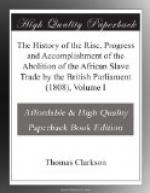In consequence then of these different circumstances, the society of Pennsylvania, the object of which was “for promoting the abolition of slavery and the relief of free Negros unlawfully held in bondage,” became so popular, that in the year 1787 it was thought desirable to enlarge it. Accordingly several new members were admitted into it. The celebrated Dr. Franklin, who had long warmly espoused the cause of the injured Africans, was appointed president; James Pemberton and Jonathan Penrose were appointed vice-presidents; Dr. Benjamin Rush and Tench Coxe, secretaries; James Star, treasurer; William Lewis, John D. Coxe, Miers Fisher, and William Rawle, counsellors; Thomas Harrison, Nathan Boys, James Whiteall, James Reed, John Todd, Thomas Armatt, Norris Jones, Samuel Richards, Francis Bayley, Andrew Carson, John Warner, and Jacob Shoemaker, junior, an electing commitee; and Thomas Shields, Thomas Parker, John Oldden, William Zane, John Warner, and William McElhenny, an acting commitee for carrying on the purposes of the institution.
I shall now only observe further upon this subject, that as a society, consisting of an union of the Quakers, with others of other religious denominations, was established for Pennsylvania in behalf of the oppressed Africans, so different societies, consisting each of a similar union of persons, were established in New York, Connecticut, New Jersey, Delaware, Maryland, and other states for the same object, and that these afterwards held a correspondence and personal communion with each other for the promotion of it.
CHAPTER VI.
Observations on the three classes already introduced—Coincidence of extraordinary circumstances—Individuals in each of these classes, who seem to have had an education as it were to qualify them for promoting the cause of the abolition—Sharp and Ramsay in the first—Dillwyn in the second—Pemberton and Rush in the third—These, with their respective classes, acted on motives of their own, and independently of each other—and yet, from circumstances neither foreseen nor known by them, they were in the way of being easily united in 1787—William Dillwyn, the great medium of connection between them all.
If the reader will refer to his recollection, he will find, that I have given the history of three of the classes of the forerunners and coadjutors in the great cause of the abolition of the Slave-trade up to the time proposed. He will of course expect that I should proceed with the history of the fourth. But, as I foresee that, by making certain observations upon the classes already introduced in the present rather than in any future place, I shall be able to give him clearer views on the subject, I shall postpone the history of the remaining class to the next chapter.




